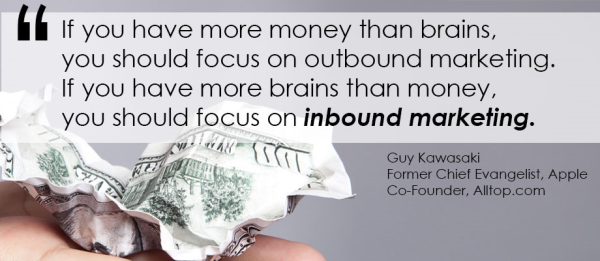To answer this question, let’s start at the beginning and define what exactly is inbound marketing. So
What is Inbound Marketing?
World-renowned marketing David Meerman Scott describes inbound marketing in the quote below:
Simply put, Inbound marketing is the most effective way to market in today’s world. Inbound marketing focuses on attracting prospects to your website and social media channels by providing information when clients need it and are seeking it. This helps businesses build trust and relationships with potential customers when they are searching for answers and information.
Outbound marketing, on the other hand, is a traditional marketing method that focuses on pushing marketing messages to prospects through ways like direct mail, television commercials, print advertisements, telemarketing, and tradeshows. We often call outbound marketing “interruption marketing” because you are trying to get people to pay attention to your marketing messages when they are not looking for your help.
So what are the problems with Outbound marketing?
Outbound marketing is becoming less and less effective and it’s expensive. Studies show prospects commonly complain about being marketed to. They distrust marketing messages. And they complain about being interrupted by unwanted advertising messages.
For example, consider traditional outbound marketing methods such as television and radio commercials, telemarketing, banner advertisements, direct mail and buying email lists. Not only are these methods expensive, but prospects use tools like digital video recorders, satellite radio, and spam email filters to completely avoid these messages. They also subscribe to “do not call” and “do not mail” lists.
Plus, outbound marketing is pricey. According to one study of marketers and executives, outbound marketing requires companies spend 62% more per lead than inbound marketing methods.
More on why to use Inbound Marketing:
Consider these stats that show people make their buying decisions by using the Internet, not by watching or reading traditional outbound marketing.
[unordered_list style=’circle’ number_type=’circle_number’ animate=’no’ font_weight=”]- 90% of Consumer Buying Decisions Start on the Web.Forrester Research
- 60% of The Sales Cycle Happens By Consumers Self-Educating About Products and Services Before Reaching Out to a Sales Person. Forrester Research
- 92% of Online Users First Use Search Engines to look for products and services. HubSpot
- 71% of B2B Buyers go to the Internet to get Industry Specific Information. HubSpot
How do you start with with inbound marketing?
There are 3 steps in the inbound marketing cycle.
Step 1: Get Found Online
[unordered_list style=’circle’ number_type=’circle_number’ animate=’no’ font_weight=”]
- You must know your customers. Know the core questions and needs of your ideal customers, the customers who provide the majority of revenue for your business. You should know the answers to questions such as: “What are their biggest challenges?”, “What do they search for when using the web and social media?”, and “What do they need to help them do their work most effectively and efficiently?”
- Make your website visible and accessible to potential customers who are searching the web for the types of products and services you provide.
- Optimize your website content and social media activities for search engines (SEO) to get found by your core customers.
Step 2: Convert Website Visitors Into Leads and Then Customers
[unordered_list style=’circle’ number_type=’circle_number’ animate=’no’ font_weight=”]
- Getting found online is only the first step in achieving real, measurable business results with digital marketing. Once you attract a potential customer to your website, you want to gather their contact information so you can begin a relationship with them. You need to offer potential customers something of value (e.g., eBook, eNewsletter, Buyers’ Guides, etc.) so they see the value of sharing their information with you. When they do this, they become alead. You can begin building a relationship with this potential customer and learn more about their specific wants, needs and concerns.
- After you convert your visitors into leads, it’s critical to nurture them through the buying process. People do business with those they know, they like and they trust. Thislead nurturing process will help people get to you know and your services, as well as see you as a business they can trust. This helps you convert them from a lead into apaying customer.
Step 3: Analyze, Repeat and Improve
[unordered_list style=’circle’ number_type=’circle_number’ animate=’no’ font_weight=”]- You always need to monitor your online activities to learn which activities are most important and most profitable. As you learn what pays the biggest dividends, you can invest in those activities with confidence, knowing they are worth the investment of your time and resources. We use a process and software that’s second to none to help you measure and analyze your digital marketing strategies. With the monthly reports you receive, you can be confident you are getting a positive return.
If you have questions about how to begin with inbound marketing, we’re happy to provide you with a free 30 minute consultation along with our soon-to-be-released Beginner’s Guide to Inbound Marketing.
Also, be sure to check out our inbound marketing case study reviews of River Pools and Spas as well as Block Imaging.



